The Museum Collections
Introduction
I. History and Art Collection
1. Icons of the 14th – 19th centuries
icons of the 14th – 17th century
2. Jewelry art of the 14th – 20th century
jewelry art of the 14th – 17th century
jewelry art of the 18th – 19th century
the european silver 14th - 19th centuries
3. Small-size sculptures (works of metal, wood, bone)
XI – the beginning of the XX century
Small-size sculptures 11th – 17th century
Small-size sculptures 18th – early 20th century
enamel of Troitza masters 15-8th – early 20th century
5.Embroidery, lace, textiles of the 14th - early 20th century
icon and ornamental embroidery
gold and silver lace
6.Painting of the 18th – 21st centuries
painting of the 18th – 19th centuris
painting of the 20th – 21st centuris
II.Manuscripts and old printed books of the 14th – 17th century
IV.Lithography of the 18th – 19th century
V.Numismatics
VI.Medals of the 18th - early 20th century
VIII.Archeology collection
IX. Russian folk and applied and decorative art of the 17th – 21st c.
1. Artistic wood
folk carved and painted wood
wooden toys
house carving of Sergiev Posad
Khokhloma and Gorodets painting
2. Artistic textiles
embroidery and weaving
printed textiles and lace
Russian shawls
folk costumes
folk garments
printed cotton kerchiefs
|
Icons of the 14th – 17th cc. (page 1)
|
Icon painting justly occupies an outstanding place in Old Russian art. It is “a real manifestation of spiritual life of the whole nation”. The Museum collection of icons includes different schools and original iconographies. You can see here rare monuments of the 14th century, works of Andrei Rublev circle and its successors, various specimens of the 16th century, icons of Stroganov and Godunov painters of the early 17th century and icons of the tsar isographert of the second half of the 17th century – Simon Ushakov.
Small prayer icons with the image of the Virgin in various iconographies constitute a considerable part of the collection. The most widespread images: the Virgin Hodigitria, the Virgin Eleousa, the Virgin of Tikhvin, the Virgin of Kazan, etc. – were usually family relics of Moscow princes and boyars, donated or brought on the coffins and left in memory of the people buried in the Monastery, according to the old tradition. Numerous icons with the image of the Virgin demonstrate great skill in expressing various shades of feelings even within the limits of the same iconography.
The earliest specimens date back to the second half of the 14th century. Originating from different places, they demonstrate artistic interests of the Moscow principality. At that time Moscow was well acquainted with ancient traditions of South Slavonic countries, Byzantium and Old Russian centers. “St. Anna with the Child Mary” demonstrates identity with Serbian icons of the 14th century in its unusual iconography, manner of painting and color scheme. This icon is connected with Voyeyko Voytegovich, a son of the Serbian nobleman. “The Virgin Perivleptos” reminds of close relations between Russia and Byzantium. Its Constantinople origin was recorded in the Monastery documents. The icon was believed to have been painted by Ignatius the Greek who was commissioned by Prince Yury Dmitriyevich of Zvenigorod, the son of Dmitry Donskoi. “St. Nicholas of Myra Lycia” called “St. Nicholas” in Russia was the cell icon of the Monastery founder Sergius of Radonezh. It shows characteristic features of Rostov icon-painting.
( Now the icon is in the Trinity-St. Sergius Lavra).
|
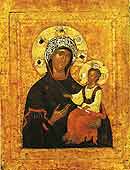
The Virgin Perivleptos.
Secons half of the 14th c. Byzantium |
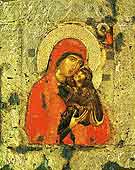
St. Anna with the Child Mary.
14th c. Serbia (?) |
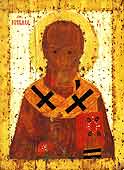
St. Nicholas. 14th c. Rostov.
Cell icon of Sergius of Radonezh.
|
|
The special group of the late 14th - early 15th c., connected with the Moscow Principality, characterize one of the most interesting periods in Russian history when Moscow became the center of unification of the Russian lands. “The Virgin of the Don” was probably painted in Theophan the Greek’s manner. The icon, that once belonged to Boyar Mikhail Vassilievich Obraztsov, shows one of the most perfect images of the Virgin in Moscow art of the turn of the 15th c.
|

The Virgin of the Don.
Late 14th – early 15th century. |
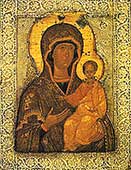
The Virgin Hodigitria. Late 14th –
early 15th century. Once belonged
to Princess Anna Mikulinskaya. |
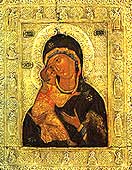
The Virgin of Vladimir. Late 14th –
early 15th century. Donated by Mikhail
Vassilievich Obraztsov
|
|
Ìoscow art at the turn of the 15th c. was brilliantly reflected in Andrei Rublev works. Andrei Rublev’s name was inseparably connected with the Trinity-St. Sergius Monastery. Here his youth passed, and here he most probably took monastic vows. He painted “The Trinity of Old Testament” (State Tretyakov Gallery) in praise of Sergius of Radonezh. His team painted icons for the iconostasis of the Trinity Cathedral, constructed above the tomb of Venerable Sergius. The iconostasis is a picturesque ensemble which has survived in the interior for which it was created.
The Museum displays the Royal Doors from the Trinity Cathedral. The simple reasoned composition, soft, echoing lines, expressive silhouettes, gentle color scheme testify to a great talent of the unknown artist of Rublev school. The Evangelists are reserved and absorbed in spiritual thoughts.
|
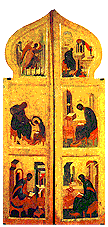
The Royal Doors. The Annunciation and the Evangelists. 1425 – 1427. Andrei Rublev workshop. |
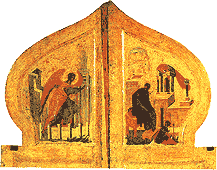
The Royal Doors. Detail. The Annunciation and the Evangelists. 1425 – 1427. Andrei Rublev workshop. |
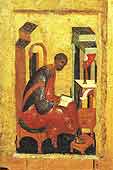
The Royal Doors. Detail. The Evangelists. 1425 – 1427. Andrei Rublev workshop.
|
|


